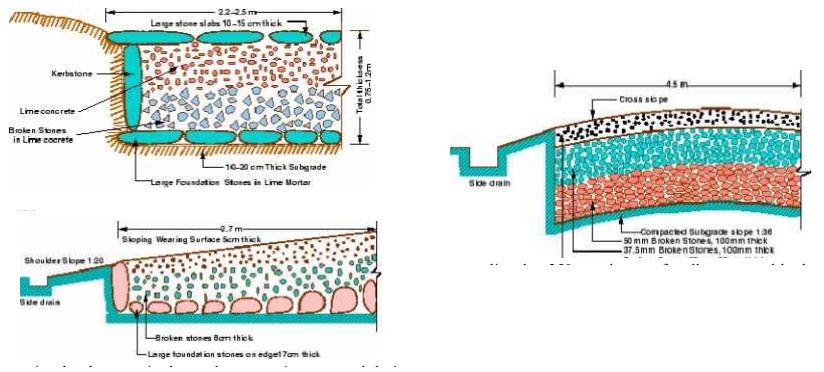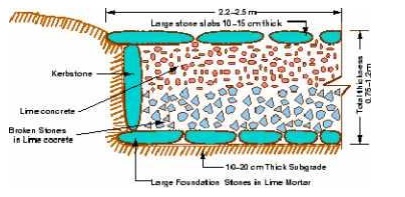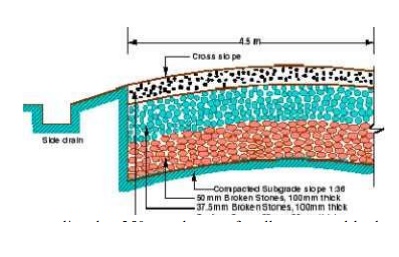Chapter: Civil : Highway Planning and Alignment : Highway Engineering
History of highway engineering

History of highway engineering
The history of highway enginnering gives us an idea about
the roads of ancient times. Roads in Rome were constructed in a large scale and
it radiated in many directions helping them in military operations. Thus they
are considered to be pioneers in road construction. In this section we will see
in detail about Ancient roads, Roman roads, British roads, French roads etc.
1 Ancient Roads
The first mode of transport was by foot. These human
pathways would have been developed for specific purposes leading to camp sites,
food, streams for drinking water etc. The next major mode of transport was the
use of animals for transporting both men and materials. Since these loaded
animals required more horizontal and vertical clearances than the walking man,
track ways emerged. The invention of wheel in Mesopotamian civilization led to
the development of animal drawn vehicles. Then it became necessary that the
road surface should be capable of carrying greater loads. Thus roads with
harder surfaces emerged. To provide adequate strength to carry the wheels, the
new ways tended to follow the sunny drier side of a path. These have led to the
development of foot-paths. After the invention of wheel, animal drawn vehicles
were
developed
and the need for hard surface road emerged. Traces of such hard roads were
obtained from various ancient civilization dated as old as 3500 BC. The
earliest authentic record of road was found from Assyrian empire constructed
about 1900 BC.
2 Roman roads

The earliest large scale
road construction is attributed to Romans who constructed an extensive system
of roads radiating in many directions from Rome. They were a remarkable
achievement and provided travel times across Europe, Asia minor, and north
Africa. Romans recognized that the fundamentals of good road construction were
to provide good drainage, good material and good workmanship. Their roads were
very durable, and some are still existing. Roman roads were always constructed
on a firm
formed
subgrade strengthened where necessary with wooden piles. The roads were
bordered on both sides by longitudinal drains. The next step was the
construction of the agger. This was a raised formation up to a 1 meter
high and 15 m wide and was constructed with materials excavated during
the side drain construction. This was then topped with a sand leveling course.
The agger contributed greatly to moisture control in the pavement. The pavement
structure on the top of the agger varied greatly. In the case of heavy traffic,
a surface course of large 250 mm thick hexagonal flag stones were provided. A
typical cross section of roman road The main features of the Roman roads are
that they were built straight regardless of gradient and used heavy foundation
stones at the bottom. They mixed lime and volcanic puzzolana to make mortar and
they added gravel to this mortar to make concrete. Thus concrete was a major
Roman road making innovation.
3 French roads

The next major development in the road construction
occurred during the regime of Napoleon. The significant contributions were
given by Tresaguet in 1764 and a typical cross section of this road. He
developed a cheaper method of construction than the lavish and locally
unsuccessful revival of Roman practice. The pavement used 200 mm pieces of
quarried stone of a more compact form and shaped such that they had at least
one flat side which was placed on a compact formation.
Smaller pieces of broken stones were then compacted into
the spaces between larger stones to provide a level surface. Finally the
running layer was made with a layer of 25 mm sized broken stone. All this
structure was placed in a trench in order to keep the running surface level
with the surrounding country side. This created major drainage problems which
were counteracted by making the surface as impervious as possible, cambering
the surface and providing deep side ditches.
He gave much importance for drainage. He also enunciated
the necessity for continuous organized maintenance, instead of intermittent
repairs if the roads were to be kept usable all times. For this he divided the
roads between villages into sections of such length that an entire road could
be covered by maintenance men living nearby.
4 British roads
The British government
also gave importance to road construction. The British engineer John Macadam
introduced what can be considered as the first scientific road construction
method. Stone size was an important element of Macadam recipe. By empirical
observation of many roads.

he came to realize that 250 mm layers of well compacted
broken angular stone would provide the same strength and stiffness and a better
running surface than an expensive pavement founded on large stone blocks. Thus
he introduced an economical method of road construction.
The
mechanical interlock between the individual stone pieces provided strength and
stiffness to the course. But the inter particle friction abraded the sharp
interlocking faces and partly destroy the effectiveness of the course. This
effect was overcome by introducing good quality interstitial finer material to
produce a well-graded mix. Such mixes also proved less permeable and easier to
compact.
Related Topics